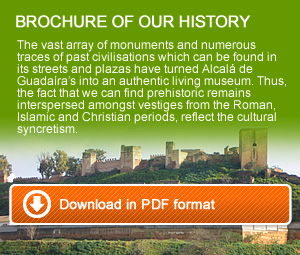

The main space is Mesa (Plateau) de Gandul, a ridge of Los Alcores facing Guadaíra's countryside, where human occupation has been continuous from Prehistory to the present time. Around the Mesa there are other areas with various values: Las Canteras, Bencarrón and La Dehesa.
Where does Gandul's name come from? There are several hypotheses, but the most probable one is that it comes from Arab gandul, name given to shrubs like gorse or broom that are still plentiful at the paths of the area.
Today Gandul is a place where many cultural and heritage values coexist. It is an ample archaeological site, with first signs dating back to the Chalcolithic Period (ca. five thousand years ago). At this moment the Mesa is occupied by a settlement surrounded by a wide zone of monumental burials: they are the "dolmens", more accurately Megalithic Passage Tombs. Although the Mesa has not been excavated, a high number of these burials are known, similar to the ones that have been discovered at the region. Among the most known ones are The Vaquero Cave, Las Canteras Tholos, Pedrejón's Tomb, La Casilla and El Término dolmens, etc.
Gandul's historic development has another important moment in Tartessian and Turdetani Periods (8th-4th centuries BCE), when the Plateau's village becomes stronger, being this a sign of its importance in the region. At its surroundings several funerary zones are located; among them the one of Bencarrón stands out, where several burial mounds with "princely" tombs are placed, being found among other pieces several carved ones of ivory of Phoenician origin.
Already in Early Roman Empire Period (1st-3rd centuries CE), Gandul is completely developed as urbanized and walled town, with a series of agricultural centres (villae) at its surroundings, as well as craft areas and funerary spaces. Among these ones Las Canteras necropolis stands out, with singular elements like the Circular Mausoleum, dated from ca. 1st century CE and that can still be seen at the foot of the road from Gandul to Mairena del Alcor.
La Mesa settlement seems to be over during the Andalusian Period (about the 12th century), although there are no evidences regarding this matter. By the 12th century the emergence of a new enclave not far away, Gandul's village, takes place, around a great tower that controlled the way of Los Alcores. From this moment on, the settlement would be concentrated in the village, which from the 13th century will join the dominion of Gandul and Marchenilla.
Today, along with the archaeological and historic values Gandul hoards a valuable cultural and natural heritage. In its area several landscapes are combined: Los Alcores Escarpment, Gandul's Meadow, the Eucalyptus Plantation... Also its privileged situation allows a complete visibility of the Guadaíra Countryside or Campiña, reaching the Morón Mountains and Osuna. This landscape and ecological richness is completed with an ample social use that makes this peri-urban space one of the most valued ones by Alcalá's citizenry.

